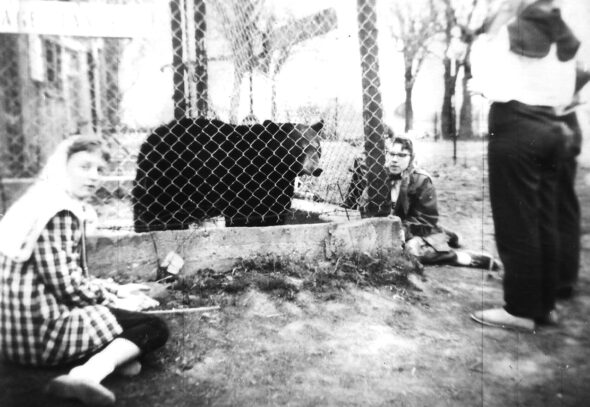
Muggins, a black bear born in Canada, lived the majority of her life in Clifton Gorge. She’s pictured here in her summer cage, getting treats from visitors in the 1950s. (Submitted photo)
The tale of Muggins, the black bear in Clifton Gorge
- Published: April 12, 2025
By Don Cipollini
Clifton Gorge is a narrow limestone gorge, formed 15,000 years ago by glacial meltwater, that extends for about a mile downstream from Clifton Mill -— both popular tourist attractions in Greene County. “The gorge” is a natural wonder, harboring plants like white cedars and eastern hemlocks far removed from their typical range that persist in the “refrigerated” microclimate that the gorge maintains.
While the gorge has been a state nature preserve since 1973, it was once a private tourist attraction called Ferndale Park. Folks could hike the gorge, take boat rides up the Little Miami River and purchase ferns harvested from the cliff sides. But visitors who stopped by George Washington Grindle’s stand perched near the rim of the gorge would have witnessed a rare sight in Ohio: Muggins, a caged black bear.
Black bears are native to Ohio and would have once roamed freely in Greene County, but they were largely eliminated from the state by hunting and habitat destruction by 1850. Through natural dispersal from neighboring states and habitat restoration, bears have slowly come back and a small population of them currently exists in eastern Ohio, estimated at around 100 individuals by the Ohio Department of Natural Resources. It is rare for them to visit western Ohio, but young males have occasionally been spotted in this part of the state, far from home, wandering river corridors.
In the mid 1900s, however, black bears were virtually nonexistent in Ohio. Many people have fond memories of visiting the gorge to see and interact with Muggins, the only black bear they would have likely seen, at least up close and in person.
It is generally understood that Muggins, a female, was brought to Ohio as a cub from Canada after her mother was killed. The story goes that Grindle and a friend (a Mr. Stafford of Yellow Springs, first name unknown) were observing a bear at a dump when it became unruly and charged. They shot the bear and discovered she had been protecting two cubs, one of whom would become Muggins. They brought it back to Ohio, where Stafford appeared to be the original owner, keeping Muggins on a leash outside of his auto repair business in Springfield until his wife and customers nixed the idea.
Interestingly, a newspaper article from 1933 described another black bear cub named Muggins brought to Ohio from Canada by Harry Sutton, of Xenia. Although the article indicated that this Muggins was a male, the origin story was similar in that this cub was supposedly rescued with his brother when their mother was killed. Sutton died in 1941, his farm was sold, and there are no other recorded mentions of a bear named Muggins in the area until 1968. It seems quite coincidental that Muggins, a Canadian bear of similar age who lived for decades in the gorge under the ownership of Grindle, was a different Muggins than the one brought to Xenia by Sutton in 1933, but the relationship between these bears is unknown.
To Grindle, Muggins was a family pet that he could walk on a leash and lounge with while her head rested in his lap; to visitors, she was a source of entertainment. Tourists would feed Muggins snacks and drinks from Grindle’s stand, with orange soda pop an apparent favorite. In response, Muggins grew to 450 pounds — much larger than the average 175-pound female.
Black bears live for about 18 years on average in the wild, so despite this fast-food diet, Muggins was the oldest bear on record at the time at around 40 years old at her death. The current longevity records for black bears are 39 years in the wild and 44 years in captivity. The photo above is from about 1950, showing a visitor feeding Muggins in her summer cage at Clifton. Others from the era show her standing upright drinking from a soda pop bottle held by a visitor through the fence; she would apparently perform tricks as well. Over the winter, Muggins would sleep in a large hollow log near Grindle’s residence. After decades in the limelight, Muggins’ run as the darling of Clifton Gorge would come to an unfortunate end.
On June 7, 1968, some boys sawed open the lock to Muggins’ cage and may have also given her alcohol; what happened next is the subject of some debate. One story claims that Muggins chased the boys who had released her. Another suggests that, upon the discovery of Muggins’ release, Grindle — who was 82 years old at the time — and a friend tussled with the normally docile bear in an attempt to return her to her cage. Either way it happened, Muggins tumbled into the gorge 30 feet below and went missing. She wandered the gorge alive for some time after her escape, as searchers spotted her on a few occasions.
Unfortunately, Muggins was never recaptured and was found dead five days later with a broken neck in the river shallows near Steamboat Rock — a large limestone block that slumped from the cliff face in a most-certainly dramatic fashion at some point in the past. It resides in the center of the Little Miami River about a half mile downstream from where Muggins reportedly fell. When younger, Muggins would play in the water near this rock under the watchful eye of Grindle, and it is thought she may have wandered to this location in her injured state out of familiarity. She may have also died upstream and washed down to this location.
Because of her large size, it was decided that Muggins would be cremated, presumably on the riverbank nearby. Associates of the Dayton Society of Natural History got word of this funeral pyre and arrived just in time to remove her head as the flames rose. The skull of Muggins was prepared and was on public display for many years at The Dayton Museum of Natural History, now The Boonshoft Museum of Discovery, where it can still be seen. On it, one can observe her significantly worn teeth, indicative of her great age. Grindle passed away at the age of 89 in 1975, just seven years after Muggins, and was buried in the Clifton Union Cemetery, where his wife joined him two years later.
Those who remember Muggins are becoming fewer and farther between, and the life of the black bear of Clifton Gorge is one not likely to be experienced by bears again in Ohio. In 2012, then-Gov. Kasich signed a bill into law that prohibits individuals from possessing “dangerous wild animals” in Ohio, including bears, unless the animal had been in possession prior to the law coming into effect. For those that had been, requirements for enclosures have advanced significantly beyond Muggins’ rudimentary housing, as have nutritional standards and veterinary care.
While Muggins’ story is now one for the ages, her life as a captive bear in the public eye, from her Canadian origins to her tragic end at the bottom of Clifton Gorge, is one we shouldn’t forget.
*Yellow Springs resident Don Cipollini, Ph.D., is director of environmental sciences and a professor of biological sciences at Wright State University.
The Yellow Springs News encourages respectful discussion of this article.
You must login to post a comment.
Don't have a login? Register for a free YSNews.com account.















No comments yet for this article.